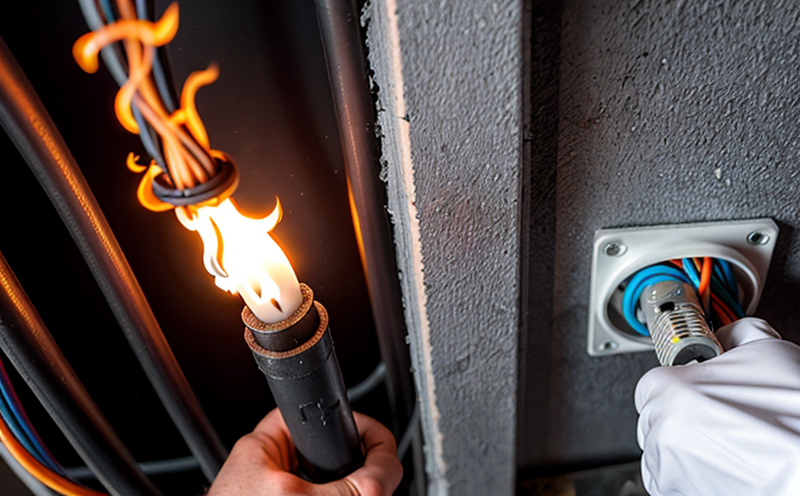Post-Fire Analysis of Cable Insulation Degradation
In today’s world, fire safety is a critical concern, especially in industries where electrical systems are integral. The integrity and reliability of cable insulation play a pivotal role in preventing fires and ensuring safe operation. Post-fire analysis of cable insulation degradation provides valuable insights into the performance of these materials under extreme conditions. This service allows for a detailed examination of how cables withstand fire exposure and the extent to which their insulating properties are compromised.
After a fire event, it is crucial to assess the condition of the insulation material used in the cables. This analysis helps in identifying potential weak points and areas that need improvement. The process involves collecting samples from the damaged cable segments, followed by thorough testing under controlled conditions. The results are then compared against pre-fire specifications to determine any degradation.
The importance of post-fire analysis extends beyond mere inspection; it serves as a critical tool for continuous improvement in fire safety standards and practices. By understanding the exact nature and extent of insulation damage, stakeholders can make informed decisions about necessary replacements or upgrades to existing infrastructure. This not only enhances operational safety but also contributes significantly to regulatory compliance.
The methodology employed in this service typically includes several key steps: sample collection from the affected area, preliminary examination for visible damage, detailed microscopic analysis of cross-sections, and quantitative measurement using specialized equipment such as Fourier Transform Infrared Spectroscopy (FTIR) or X-ray Diffraction (XRD). These techniques provide precise data on molecular changes within the insulation material.
Understanding the root cause of degradation is essential for effective mitigation strategies. Environmental factors like temperature, humidity, and exposure to chemicals can contribute to insulation breakdown over time. However, during a fire event, these materials face sudden extreme thermal stress which can lead to rapid deterioration. Identifying whether the failure was due to inherent defects in the material or operational conditions helps in addressing underlying issues.
For instance, if it is determined that the degradation occurred primarily because of substandard raw materials rather than environmental factors, this information becomes invaluable for procurement teams looking to source higher quality components. On the other hand, if poor installation practices were identified as a contributing factor, then training programs could be developed aimed at improving workmanship.
The findings from post-fire analyses also serve an educational purpose by providing case studies that can inform best practice guidelines and industry standards. For example, according to ISO 13943:2020, the standard specifies performance requirements for electrical equipment in fire situations but does not cover all possible scenarios encountered during actual fires. Through real-world applications of this service, we contribute towards closing those gaps by offering practical solutions based on empirical evidence.
Why It Matters
The significance of post-fire analysis cannot be overstated in terms of both immediate safety measures and long-term strategic planning. Firstly, it ensures that any issues identified are addressed promptly, thereby reducing the risk of further incidents involving similar components. Secondly, by leveraging this data, organizations can implement proactive maintenance schedules tailored specifically to their facilities' unique needs.
From a regulatory perspective, compliance with relevant standards such as IEC 60332-1 and EN 50265 is crucial for maintaining certification status. These documents outline specific requirements related to flame retardancy tests on various types of cables used in different applications ranging from household appliances to industrial machinery.
Moreover, insurance companies often require detailed reports from such analyses as part of claims processing procedures. Having accurate records documenting the extent of damage helps streamline these processes, ensuring quicker resolutions for policyholders affected by fires at their premises.
Customer Impact and Satisfaction
- Enhanced Safety: By identifying degraded insulation early on, customers can take corrective actions before they lead to catastrophic failures. This proactive approach minimizes the likelihood of future accidents.
- Better Decision Making: Insights gained through this analysis aid in making well-informed decisions regarding upgrades or replacements. It also supports strategic planning for facility expansions where new cables will be installed.
The service offers peace of mind to customers knowing that their installations are meeting the necessary safety standards and expectations set forth by regulatory bodies. Positive feedback from clients highlights how satisfied they are with receiving clear, actionable recommendations backed up by robust scientific evidence obtained through this analysis process.
Use Cases and Application Examples
- Data Centers: Ensuring that critical infrastructure remains operational during emergencies is paramount. Post-fire analysis on cables within data centers provides assurance that power distribution systems continue functioning reliably even after a fire.
- Hospitals: Given the sensitive nature of medical facilities, it is imperative to guarantee uninterrupted service. Analysis of cable insulation ensures that life support equipment operates correctly amidst potential threats like fires.
In both instances, the results from post-fire analyses are instrumental in maintaining high levels of reliability and safety across these essential sectors. Understanding how different types of cables perform under fire conditions allows for targeted improvements to be implemented promptly.





